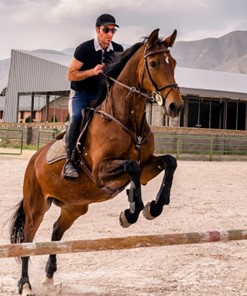Horses are magnificent creatures known for their beauty, strength, and intelligence. Understanding horse behavior is essential for anyone who works with these animals, whether as a horse owner, trainer, or equestrian enthusiast. By gaining insight into equine psychology and communication, individuals can build stronger bonds with their horses, promote positive interactions, and ensure the well-being of these majestic animals. In this article, Freddie Vasquez Jr. delves into the intricacies of horse behavior, exploring their natural instincts, social dynamics, and communication cues.
Instinctual Behavior
Horses are prey animals with finely tuned instincts developed over thousands of years of evolution. Understanding these instincts is key to comprehending horse behavior. One of the most fundamental instincts in horses is flight response – the tendency to flee from perceived threats to ensure survival. This instinct is ingrained in their DNA and influences how they react to various stimuli in their environment. Additionally, horses have a strong herd instinct, seeking safety and security in the company of other horses. Recognizing and respecting these instinctual behaviors is crucial for establishing trust and cooperation with horses.
Social Dynamics
Horses are inherently social animals that thrive in herd environments. Within a herd, horses establish complex social hierarchies based on dominance, submission, and cooperation. Understanding the dynamics of horse social structure can help horse owners and trainers manage group interactions and prevent conflicts. Dominant horses may assert their leadership through body language, vocalizations, and physical gestures, while submissive horses may exhibit deferential behaviors to avoid confrontation. By observing and interpreting these social cues, individuals can facilitate harmonious relationships within horse groups and promote a sense of security and stability.
Communication Cues
Communication is essential for establishing trust and rapport between humans and horses. While horses primarily communicate through body language and vocalizations, they are also highly attuned to human cues and gestures. Learning to interpret horse communication cues can help individuals understand their horse’s mood, emotions, and intentions. For example, pinned ears, raised tails, and bared teeth may indicate aggression or discomfort, while relaxed posture, soft eyes, and gentle nuzzling signify contentment and relaxation. By paying attention to subtle cues and responding appropriately, individuals can foster effective communication and mutual understanding with their horses.

Behavioral Patterns
Horses exhibit a variety of behavioral patterns that reflect their emotional state and well-being. Understanding these patterns can provide valuable insights into horse behavior and help identify signs of stress, anxiety, or discomfort. Common behavioral patterns include:
- Grazing: Grazing is a natural behavior for horses, allowing them to forage for food and meet their nutritional needs. Horses typically graze for several hours each day, moving from one grazing area to another in search of fresh grass and vegetation.
- Resting: Horses require periods of rest and relaxation to recharge their energy and maintain optimal health. Resting behaviors include lying down, dozing, and standing quietly with their eyes closed. Providing horses with a comfortable and safe resting environment is essential for their well-being.
- Playfulness: Horses are playful animals that enjoy engaging in recreational activities such as running, jumping, and socializing with other horses. Play behavior helps horses release pent-up energy, strengthen social bonds, and alleviate boredom. Encouraging horses to engage in playful activities can enhance their physical and mental health.
- Aggression: Like all animals, horses may display aggressive behaviors in certain situations, such as during mating, competition for resources, or territorial disputes. Aggressive behaviors include kicking, biting, and chasing, and can pose safety risks to humans and other animals. Understanding the underlying causes of aggression and implementing appropriate management strategies is essential for preventing conflicts and ensuring the safety of all individuals involved.
Conclusion
Understanding horse behavior is essential for building positive relationships, promoting well-being, and ensuring the welfare of these magnificent animals. By gaining insight into equine psychology, social dynamics, and communication cues, individuals can develop a deeper understanding of their horses’ needs and preferences. By respecting their instincts, fostering effective communication, and providing a supportive environment, horse owners, trainers, and equestrian enthusiasts can cultivate strong bonds with their horses and enjoy fulfilling partnerships based on trust, respect, and mutual understanding.
